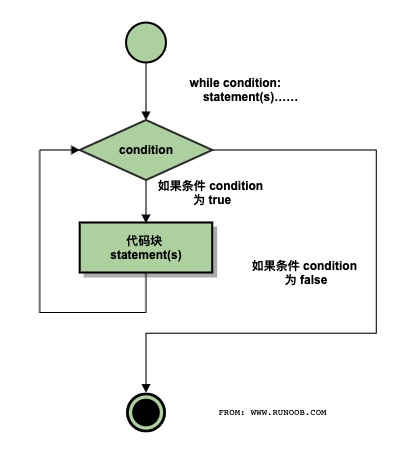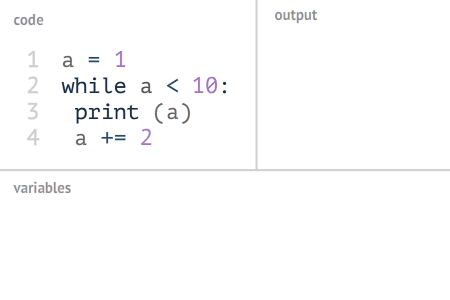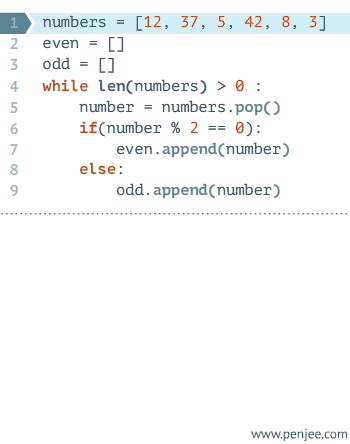Python 编程中 while 语句用于循环执行程序,即在某条件下,循环执行某段程序,以处理需要重复处理的相同任务。其基本形式为:
while 判断条件(condition):
执行语句(statements)……
执行语句可以是单个语句或语句块。判断条件可以是任何表达式,任何非零、或非空(null)的值均为true。
当判断条件假 false 时,循环结束。
执行流程图如下:

Gif 演示 Python while 语句执行过程

复杂一点:

实例
count = 0while (count < 9): print 'The count is:', count
count = count + 1
print "Good bye!"
以上代码执行输出结果:
The count is: 0The count is: 1The count is: 2The count is: 3The count is: 4The count is: 5The count is: 6The count is: 7The count is: 8Good bye!
while 语句时还有另外两个重要的命令 continue,break 来跳过循环,continue 用于跳过该次循环,break 则是用于退出循环,此外"判断条件"还可以是个常值,表示循环必定成立,具体用法如下:
i = 1while i < 10:
i += 1
if i%2 > 0:
continue
print i
i = 1while 1:
print i
i += 1
if i > 10:
break
无限循环
如果条件判断语句永远为 true,循环将会无限的执行下去,如下实例:
实例
var = 1while var == 1 :
num = raw_input("Enter a number :")
print "You entered: ", num
print "Good bye!"
以上实例输出结果:
Enter a number :20You entered: 20Enter a number :29You entered: 29Enter a number :3You entered: 3Enter a number between :Traceback (most recent call last):
File "test.py", line 5, in <module>
num = raw_input("Enter a number :")KeyboardInterrupt
注意:以上的无限循环你可以使用 CTRL+C 来中断循环。
循环使用 else 语句
在 python 中,while … else 在循环条件为 false 时执行 else 语句块:
实例
count = 0while count < 5: print count, " is less than 5"
count = count + 1else: print count, " is not less than 5"
以上实例输出结果为:
0 is less than 51 is less than 52 is less than 53 is less than 54 is less than 55 is not less than 5
简单语句组
类似 if 语句的语法,如果你的 while 循环体中只有一条语句,你可以将该语句与while写在同一行中, 如下所示:
实例
flag = 1
while (flag): print 'Given flag is really true!'
print "Good bye!"
注意:以上的无限循环你可以使用 CTRL+C 来中断循环。












发表评论:
◎欢迎参与讨论,请在这里发表您的看法、交流您的观点。